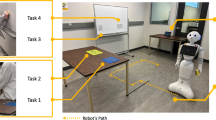Abstract
This study explores the influence of teaching methods, task complexity, and user characteristics on perceptions of teachable robots. Analysis of responses from 138 participants reveals that both Teaching with Evaluative Feedback and Teaching through Preferences were perceived as equally user-friendly and easier to use compared to the non-interactive condition. Additionally, Teaching with Evaluative Feedback enhanced robot responsiveness, while Teaching with Preferences yielded results similar to the passive Download condition, suggesting that the degree of interactivity and human guidance in the former may not substantially impact user perceptions. Personality traits, particularly extraversion and intellect, shape teaching method preferences. Task complexity influenced the perceived anthropomorphism, control, and responsiveness of the robot. Notably, the classification task led to higher anthropomorphism, control, and responsiveness scores. Our findings emphasise the importance of task design and the need of tailoring teaching methods to the user’s personality to optimise human-robot interactions, particularly in educational contexts. Project website: https://sites.google.com/view/teachable-robots.
Access this chapter
Tax calculation will be finalised at checkout
Purchases are for personal use only
Similar content being viewed by others
References
Bartneck, C., Kulić, D., Croft, E., Zoghbi, S.: Measurement instruments for the anthropomorphism, animacy, likeability, perceived intelligence, and perceived safety of robots. Int. J. Soc. Robot. 1, 71–81 (2009). https://doi.org/10.1007/s12369-008-0001-3
Belanche, D., Casaló, L.V., Flavián, C.: Integrating trust and personal values into the technology acceptance model: the case of e-government services adoption. Cuadernos de Economía y Dirección de la Empresa 15(4), 192–204 (2012)
Belpaeme, T., Kennedy, J., Ramachandran, A., Scassellati, B., Tanaka, F.: Social robots for education: a review. Sci. Robot. 3(21), eaat5954 (2018)
Belpaeme, T., Tanaka, F.: Social robots as educators. In: OECD Digital Education Outlook 2021 Pushing the Frontiers with Artificial Intelligence, Blockchain and Robots: Pushing the Frontiers with Artificial Intelligence, Blockchain and Robots, p. 143. OECD Publishing, Paris (2021)
Chetouani, M.: Interactive robot learning: an overview. In: Chetouani, M., Dignum, V., Lukowicz, P., Sierra, C. (eds.) ACAI 2021. LNAI, vol. 13500, pp. 140–172. Springer, Cham (2023). https://doi.org/10.1007/978-3-031-24349-3_9
Christiano, P.F., Leike, J., Brown, T., Martic, M., Legg, S., Amodei, D.: Deep reinforcement learning from human preferences. In: Advances in Neural Information Processing Systems, vol. 30 (2017)
Delgosha, M.S., Hajiheydari, N.: How human users engage with consumer robots? A dual model of psychological ownership and trust to explain post-adoption behaviours. Comput. Hum. Behav. 117, 106660 (2021)
Donnellan, M.B., Oswald, F.L., Baird, B.M., Lucas, R.E.: The mini-IPIP scales: tiny-yet-effective measures of the Big Five factors of personality. Psychol. Assess. 18(2), 192 (2006)
Faulkner, T.A.K., Thomaz, A.L.: Using learning curve predictions to learn from incorrect feedback. In: 2023 IEEE International Conference on Robotics and Automation (ICRA), pp. 9414–9420. IEEE (2023)
Field, Z., Miles, J., Field, A.: Discovering Statistics Using R, pp. 1–992 (2012)
Hejna III, D.J., Sadigh, D.: Few-shot preference learning for human-in-the-loop RL. In: Conference on Robot Learning, pp. 2014–2025. PMLR (2023)
Ho, M.K., MacGlashan, J., Littman, M.L., Cushman, F.: Social is special: a normative framework for teaching with and learning from evaluative feedback. Cognition 167, 91–106 (2017)
Jamet, F., Masson, O., Jacquet, B., Stilgenbauer, J.L., Baratgin, J.: Learning by teaching with humanoid robot: a new powerful experimental tool to improve children’s learning ability. J. Robot. 2018, 1–11 (2018)
Johal, W.: Research trends in social robots for learning. Curr. Robot. Rep. 1, 75–83 (2020). https://doi.org/10.1007/s43154-020-00008-3
Knox, W.B., Stone, P.: Interactively shaping agents via human reinforcement: the TAMER framework. In: Proceedings of the Fifth International Conference on Knowledge Capture, pp. 9–16 (2009)
Lee, K., Smith, L., Abbeel, P.: PEBBLE: feedback-efficient interactive reinforcement learning via relabeling experience and unsupervised pre-training. arXiv preprint arXiv:2106.05091 (2021)
Loftin, R., et al.: Learning behaviors via human-delivered discrete feedback: modeling implicit feedback strategies to speed up learning. Auton. Agent. Multi-Agent Syst. 30, 30–59 (2016). https://doi.org/10.1007/s10458-015-9283-7
Moorman, N., Hedlund-Botti, E., Schrum, M., Natarajan, M., Gombolay, M.C.: Impacts of robot learning on user attitude and behavior. In: Proceedings of the 2023 ACM/IEEE International Conference on Human-Robot Interaction, pp. 534–543 (2023)
Najar, A., Chetouani, M.: Reinforcement learning with human advice: a survey. Front. Robot. AI 8, 584075 (2021)
Rohlfing, K.J., et al.: Social/dialogical roles of social robots in supporting children’s learning of language and literacy-a review and analysis of innovative roles. Front. Robot. AI 9, 251 (2022)
Schrum, M., Ghuy, M., Hedlund-Botti, E., Natarajan, M., Johnson, M., Gombolay, M.: Concerning trends in likert scale usage in human-robot interaction: towards improving best practices. ACM Trans. Hum.-Robot Interact. 12(3), 1–32 (2023)
Thomaz, A.L., Breazeal, C.: Teachable robots: understanding human teaching behavior to build more effective robot learners. Artif. Intell. 172(6–7), 716–737 (2008)
Webots: open-source Mobile Robot Simulation Software. http://www.cyberbotics.com
Yang, X.J., Unhelkar, V.V., Li, K., Shah, J.A.: Evaluating effects of user experience and system transparency on trust in automation. In: Proceedings of the 2017 ACM/IEEE International Conference on Human-Robot Interaction, pp. 408–416 (2017)
Acknowledgements
We thank Dimitri Lacroix for his statistical insights during the initial design of the study. This research was supported by European Union’s Horizon 2020 research and innovation programme under the Marie Skłodowska-Curie grant agreement No. 955778. For the purpose of open access, the author has applied a Creative Commons Attribution (CC BY) licence to any Author Accepted Manuscript version arising from this submission.
Author information
Authors and Affiliations
Corresponding author
Editor information
Editors and Affiliations
Rights and permissions
Copyright information
© 2024 The Author(s), under exclusive license to Springer Nature Singapore Pte Ltd.
About this paper
Cite this paper
Tarakli, I., Di Nuovo, A. (2024). User Perception of Teachable Robots: A Comparative Study of Teaching Strategies, Task Complexity and User Characteristics. In: Ali, A.A., et al. Social Robotics. ICSR 2023. Lecture Notes in Computer Science(), vol 14454. Springer, Singapore. https://doi.org/10.1007/978-981-99-8718-4_31
Download citation
DOI: https://doi.org/10.1007/978-981-99-8718-4_31
Published:
Publisher Name: Springer, Singapore
Print ISBN: 978-981-99-8717-7
Online ISBN: 978-981-99-8718-4
eBook Packages: Computer ScienceComputer Science (R0)




